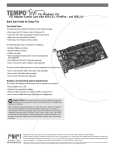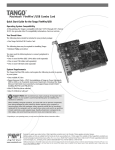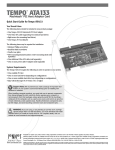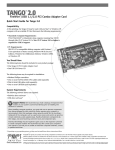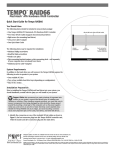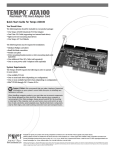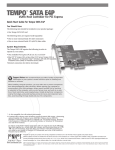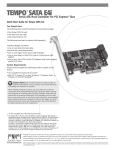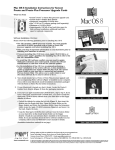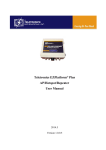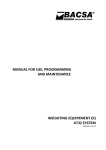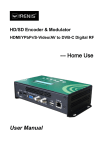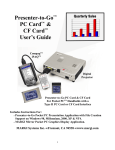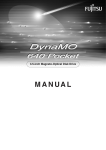Download Now - Sonnet Technologies
Transcript
Special Instructions for Tempo HD (Without Drive, Windows Version) You Should Have (Part Number THD-W) In addition to the parts listed on the Tempo HD quick start guide, the following items should be included in your product package: • 4 hard drive mounting screws The following item is required for installation of a 2.5 inch hard drive to the Tempo HD: • Medium Phillips screwdriver The following items may be required for installation of a 2.5 inch hard drive: jumper block • Small flat blade screwdriver • Needle-nose pliers Installation Preparation: Figure 1 Prior to installing a hard drive onto the Tempo HD, you may need to prepare the drive by installing, moving or removing jumpers. 1. Remove your 2.5 inch hard drive from its packaging. 2. Locate the jumper block on your hard drive. Figure 1 shows the most common jumper block location. hard drive’s pins surfacemounted connector . Support Note: Refer to the hard drive user’s manual for jumper setting information specific to your drive. Alternately, you may find jumper setting information printed on your hard drive’s labels. Make sure the drive is oriented the same way as the illustration before moving jumpers. 2.5 Inch Hard Drive Installation Steps 2.5 inch hard drive This section covers the configuration, and the installation one 2.5 inch hard drive onto your Tempo HD card. Figure 2 1. Move, install, or remove jumpers (as necessary) on the hard drive to the master setting. Tempo HD 2. Remove the Tempo HD card from its anti-static packaging, and lay it on a flat surface with the surface-mounted connector face up. screw screw 3. Lay the 2.5 inch hard drive on the card within the rectangle imprinted on the Tempo HD card, and align the hard drive’s pins with the Tempo HD card’s surface-mounted connector (Figure 2). Push the hard drive’s pins into the Tempo HD card's connector until the drive is completely seated. 4. Holding the drive against the card, flip the assembly over. Using the 4 screws provided, secure the hard drive to the Tempo HD; be sure to use the correct holes, and do not overtighten the screws (Figure 3). 5. Follow the instructions in the attached quick start guide to install the Tempo HD into your system. Please note, you will need to format the drive you just installed. Refer to the drive formatting information sections of the Quick Start Guide for specific information. screw screw Figure 3 TEMPO HD Integrated Hard Drive/PCI Card for Windows PCs ™ ® Quick Start Guide for Tempo HD You Should Have The following items should be included in your product package: • Tempo HD Integrated Hard Drive/PCI Card • Tempo HD Windows Driver diskette The following items may be required for installation of the Tempo HD: • Medium Phillips screwdriver The following items may be required for installation of additional hard drives: • Small flat blade screwdriver • Needle nose pliers Along with one or more available drive bays, the following items, which are sold separately, may be required for installation of additional hard drives: • Ultra ATA cable • Drive mounting brackets/carriers or drive mounting sleds • Hard drive mounting screws • One or more power cable Y-adapters Hardware and Operating System Requirements The Tempo HD requires the following in order to operate in your system: • One available 2.1 PCI slot • Pentium II (or equivalent) or higher • Windows 98SE, Windows Me, Windows 2000, or Windows XP . Support Note: We recommend that you make a backup of important information on your system’s current hard drive(s) prior to installing new hardware or software. When handling computer products, you must take care to prevent components from being damaged by static electricity. Before opening your computer or removing parts from their packages, always ground yourself first by touching an unpainted metal part of the computer, such as a port access cover, and work in an area free of static electricity; avoid carpeted areas. Handle all electrical components only by their edges, and avoid touching connector traces and component pins. Remember to register your product online at http://registration.sonnettech.com to be informed of future upgrades and product releases. Software updates and links are available from the Sonnet web site at www.sonnettech.com. • Online support form available at http://supportform.sonnettech.com. Sonnet Technologies Customer Service hours are Mon.-Fri., 7 a.m.–5 p.m. Pacific Time • Customer Service Phone: 1-949-472-2772 • E-mail: [email protected] Sonnet Technologies, Inc., 15 Whatney, Irvine, California 92618-2808 USA • Tel: 1-949-587-3500 Fax: 1-949-457-6350 ©2002 Sonnet Technologies, Inc. All rights reserved. Sonnet, the Sonnet logotype, Simply Fast, the Simply Fast logotype, and Tempo are trademarks of Sonnet Technologies, Inc.Tempo HD includes technology by FirmTek, LLC. Other product names are trademarks of their respective owners. All specifications subject to change without notice. Printed in the USA. QS-THD-W-XXXG-E-102402 Quick Start Guide for Tempo HD (Windows Version) Installation Preparation Prior to installing the Tempo HD into your system, you should read the section in your computer’s user manual that addresses PCI card installation. Tempo HD Tempo HD Installation Steps PCI slots This section covers the installation of the Tempo HD without additional hard drives into your system. For information on attaching additional hard drives, see page 4. 1. Shut down your computer. 2. Open your computer to access its expansion card area (PCI slots); refer to your computer’s user manual for specific information. 3. Remove the Tempo HD card from its anti-static packaging. The location of your computer’s PCI slots may vary from this illustration. Figure 1 4. Locate an available PCI slot inside your computer and, if present, remove its port access cover from the rear of the computer. 5. Install the Tempo card into the PCI slot; make sure the card is firmly seated and secured (Figure 1). 6. If you are installing additional hard drives at this time, refer to “Hard Drive Installation Preparation” and “Hard Drive Installation Steps” on page 4. 7. Close your computer. Windows 98SE and Windows Me Driver Installation This section describes the installation of drivers to support the Tempo HD in systems running Windows 98SE or Windows Me. If your system is running Windows 2000 or Windows XP, skip to the next page. 1. Turn on your computer; during Windows startup, the New Hardware Found window will briefly appear, with PCI Mass Storage Device listed as the new hardware type. 2. When the Add New Hardware Wizard window appears, click Next. 3. When the next window appears, select “Search for best driver for your device (Recommended),” and then click Next. 4. Insert the Tempo HD Windows Driver diskette into your floppy drive. 4. Type A:\Win9x-me, and then click Next. 5. When the message stating “Windows is now ready to install the best driver…” appears, click Next, and then click Finish. 6. At the next prompt, click Yes to restart your system; you must now format the attached drive. Skip to “Drive Formatting—Windows 98SE and Windows Me” on page 5. 2 Quick Start Guide for Tempo HD (Windows Version) Windows 2000 Driver Installation This section describes the installation of drivers to support the Tempo HD in systems running Windows 2000. If your system is running Windows 98SE or Windows Me, go back to “Windows 98SE and Windows Me Driver Installation” on page 2. If your system is running Windows XP, skip to “Windows XP Driver Installation” below. 1. Turn on your computer; during Windows startup, the New Hardware Found window will briefly appear, with Mass Storage Device listed as the new hardware type. 2. When the Found New Hardware Wizard window appears, click Next. 3. When the Install Hardware Device Drivers window appears, select “Search for a suitable driver for my device (recommended),” and then click Next. 4. When the Locate Driver Files window appears, insert the Tempo HD Windows Driver diskette into your floppy drive. 5. Select Floppy disk drives under Optional search locations and then click Next; a new window will appear. 6. Type A:\Win2000, and then click OK. 7. When the Driver Files Search Results window appears, click Next. 8. When the Digital Signature Not Found window appears, click Yes; the appropriate driver will be installed. 9. When the Completing the Found New Hardware Wizard window appears, click Finish; you must now format the attached drive. Skip to “Drive Formatting— Windows 2000 and Windows XP” on page 7. Windows XP Driver Installation This section describes the installation of drivers to support the Tempo HD in systems running Windows XP. If your system is running Windows 98SE or Windows Me, go back to “Windows 98SE and Windows Me Driver Installation” on page 2. If your system is running Windows 2000, go back to “Windows 2000 Driver Installation” above. 1. Turn on your computer; during Windows startup, a New Hardware Found pop-up will briefly appear, with Mass Storage Device listed as the new hardware type. 2. When the Found New Hardware Wizard window appears, insert the Tempo HD Driver diskette into your floppy drive. Select “Install from a specific location (Advanced),” and then click Next. 3. When the next window appears asking you to choose your search and installation options, select “Search for the best drivers in these locations,” and “Search removable media (floppy, CD-ROM…,” and then click Next. 4. When the next window appears, select “WinXP Promise…,” and then click Next. 3 Quick Start Guide for Tempo HD (Windows Version) 5. When the Hardware Installation window appears, click Continue Anyway; the appropriate driver will be installed. 40-pin/80-wire Ultra ATA cable connects to Tempo HD 6. When the Completing the Found New Hardware Wizard window appears, click Finish; you must now format the attached drive. Skip to “Drive Formatting: Windows 2000 and Windows XP” on page 9. Support Note: Technical knowledge may be required to gain access to the drive expansion bays in certain computer models. We recommend you first consult your computer’s user manual. If you feel you are unable to install the computer hardware, contact a qualified technician. master connector (black) slave connector (gray) host connector (blue) Hard Drive Installation Preparation: Prior to installing additional hard drives into your system, you should familiarize yourself with the parts to be installed. We also strongly recommend that you read the section in your computer’s user manual that addresses hard drive installation. Figure 2 1. Identify the connectors on an Ultra ATA cable (sold separately) as shown in Figure 2; the host connector plugs into the Tempo HD controller card, while the master and slave connectors plug into the hard drives. 2. Remove the hard drive from its anti-static packaging. 3. Locate the jumper block on the hard drive. Figure 3 shows the two most common jumper block locations. Support Note: Most new hard drives are factory preset for use as a single or master drive. To change the setting, you will need to reconfigure the hard drives’ jumpers. Be sure the jumpers are configured properly, otherwise, your computer may not boot, or your new drives may not be recognized. jumper block jumper block Figure 3 Hard Drive Installation Steps This section covers the installation and configuration one or two hard drives into your system. 1. Shut down your computer. 2. Open your computer to access the expansion card area (PCI slots) and drive bay(s); refer to your computer’s user manual for specific information. . Support Note: Refer to the hard drive’s user manual for jumper setting information specific to your drives. Alternately, you may find jumper setting information printed on your hard drives’ labels. Make sure the drives are oriented the same way as the illustration before moving jumpers. 3. Configure the hard drives’ jumpers as follows: • When installing one drive, you must set its jumpers to the single setting when available, or the master setting when not. • When connecting two drives, you must set the jumpers on one drive to the master setting, and to the slave setting on the other. 4. Install the hard drives into your computer’s expansion bays. (Depending on your computer model, drive mounting brackets/carriers or drive mounting sleds may be required to install your hard drives. Refer to your computer’s user manual.) 4 Quick Start Guide for Tempo HD (Windows Version) 5. Connect the drive(s) to the Ultra ATA cable (sold separately) as follows: • When connecting one drive, plug in the Ultra ATA cable’s master (black) connector to it. Verify the connector is plugged in securely (Figure 4). • When connecting two drives, connect the Ultra ATA cable’s master (black) connector to the drive with jumpers set in the master setting; connect the slave (gray) connector to the drive with jumpers configured in the slave setting. Verify the connectors are plugged in securely (Figure 4). 6. Locate the 4-pin power connector plugged into your computer’s existing hard drive. You should find at least one extra power connector near the existing drive; if you have installed only one new drive, plug the extra power connector into it. If you have installed two new drives, or there are no additional power connectors, you must use a power cable Y-adapter (sold separately). Verify the connectors are plugged in securely. 7. Route the Ultra ATA cable to the Tempo HD card; avoid heat sinks and make sure the cable will not get crushed or pinched by any part of the case when you reassemble your computer. Tempo HD Integrated Hard Drive/PCI Card Ultra ATA cable slave - jumpers single (or master*) *jumpers must be set to the master setting when two drives connected Figure 4 8. Attach the Ultra ATA cable’s host (blue) connector to the Tempo HD card. Verify the connector is plugged in securely (Figure 4). 9. Check the cable connections; make sure the cable is properly connected to the Tempo HD and the hard drives. 10. Close your computer and carefully replace its cover; be very careful not to crimp the cables. WARNING: Hard drives attached to the Tempo HD will not appear under My Computer, and can’t be used until they have been formatted; this also applies to drives with data on them, previously used in other computers. Please be aware that formatting a drive erases any data present. Drive Formatting—Windows 98SE and Windows Me Formatting prepares a hard drive for use by dividing the data area into tracks and sectors, enabling your computer to store and retrieve data from the drive. This section describes the process of formatting hard drives connected to the Tempo HD, using FDISK on systems running Windows 98SE or Windows Me. The following instructions detail the procedure to create a simple volume (single partition); if you need to format a drive with multiple partitions, refer to Windows Help for details. As an alternative, you may choose to format and partition your hard drive(s) with any software that was included with the drive, following the included instructions. 1. Turn on your computer and start Windows. 2. From the taskbar, click on Start > Programs > MS-DOS Prompt. 3. At the C:\WINDOWS > prompt, type FDISK. 4. A message will appear stating, “Your computer has a disk larger than 512 MB;” press Enter (Figure 5). 5. From the FDISK Options screen, press 5, and then press Enter. 5 Figure 5 Quick Start Guide for Tempo HD (Windows Version) 6. From the Change Current Fixed Disk Drive screen, select the last disk listed (assuming you’ve connected only one drive at this time), and then press Enter. Do not unintentionally choose an existing formatted drive. 7. When the FDISK Options screen appears again, select “Create DOS Partition or Logical DOS Drive,” and then press Enter. 8. From the Create DOS Partition or Logical DOS Drive screen, select “Create Primary DOS Partition,” and then press Enter. 9. As the primary DOS partition is created, the progress will be displayed. When drive integrity verification is complete, press Enter. 10. The progress will be displayed again, followed by the message “Primary DOS Partition created, drive letters changed or added;” press Esc to continue. Figure 6 11. When the next screen appears instructing you to restart your system, press Esc two times. 12. At the DOS prompt, type EXIT, and then press Enter. 13. From the taskbar, select Start > Shut Down… When the Shut Down window appears, select Restart, and then click OK. 14. After your computer restarts, double-click My Computer. 15. Right click on the new drive and select “Format…” (Figure 6). 16. When the Format window appears, select “Full” under Format Type, and then click Start (Figure 7). 17. When the warning window appears, click OK. Figure 7 18. While the format process continues, a progress bar will appear at the bottom of the Format window (Figure 8). 19. When the drive formatting process is complete, a Format Results window will appear; press Enter. 20. When the dialogue appears suggesting you run ScanDisk; press Enter. 21. A Windows Help window will appear; follow the instructions to run ScanDisk. Once ScanDisk is finished, your installation is complete; you may access your newly-formatted drive through your applications, as well as My Computer. Figure 8 6 Quick Start Guide for Tempo HD (Windows Version) WARNING: Hard drives attached to the Tempo HD will not appear under My Computer, and can’t be used until they have been formatted; this also applies to drives with data on them, previously used in other computers. Please be aware that formatting a drive erases any data present. Drive Formatting—Windows 2000 and Windows XP Formatting prepares a hard drive for use by dividing the data area into tracks and sectors, enabling your computer to store and retrieve data from the drive. This section describes the process of formatting hard drives connected to the Tempo HD, using the Disk Management Administrative Tool on systems running Windows 2000 or Windows XP. The following instructions detail the procedure to create a simple volume (single partition); if you need to format a drive with multiple partitions, refer to Windows Help for details. As an alternative, you may choose to format and partition your hard drive(s) with any software that was included with the drive, following the included instructions. Figure 9 1. Turn on your computer and start Windows. 2. From the taskbar, click on Start > Settings > Control Panel. 3. In the Control Panel window, double-click Administrative Tools. 4. In the Administrative Tools window, double-click Computer Management. 5. In the Computer Management window, double-click Storage in the right window pane (Figure 9). 6. In the right pane of the Computer Management window, double-click Disk Management (Local); the Write Signature and Upgrade Disk Wizard will appear (Figure 10). Click Next to continue. 7. In the Select Disk to Write Signature window, select the new disk (which should be your only option), and then click Next to continue. Figure 10 8. In the Select Disk to Upgrade window, select the new disk again (which should be your only option), and then click Next to continue. 9. When the next window appears (indicating the write signature was completed successfully), click Finish to close the window (Figure 11). Figure 11 7 Quick Start Guide for Tempo HD (Windows Version) 10. Back in the Computer Management window, scroll down to locate the new drive (listed as “unallocated”) in the lower right window pane, right-click on it, and then select “Create Volume…” (Figure 12). 11. When the Create New Volume Wizard appears, click Next. 12. When the Select Volume Type window appears, select “Simple Volume,” and then click Next (Figure 13). 13. When the Select Disks window appears, click Next. 14. When the Assign Drive Letter or Path window appears, select either the default letter or choose a new one, and then click Next. WARNING: By default, NTFS will be selected as the file system to use when you format drives. Unless you need to move the Tempo HD and hard drive(s) to another computer running Windows 98SE or Windows Me, you should use the default (NTFS) file system choice. Windows 98SE and Windows Me are incapable of using NTFS-formatted drives; those operating systems require FAT32-formatted drives. Figure 12 If you choose to change the default setting to FAT32, you should do so only when formatting hard drives with a capacity of less than35GB. Windows 2000 and Windows XP cannot “see” more than 35GB of a FAT32-formatted drive, regardless the capacity. 15. When the Format Volume screen appears, select “Perform a Quick Format,” and then click Next (Figure 14). 16. When the Completing the Create Volume Wizard screen appears, click Finish to complete the formatting procedure. Once the formatting procedure is finished, your installation is complete; you may access your newly-formatted drive through your applications, as well as My Computer. Please note, depending on the capacity of the drive you are working with, the formatting procedure may take anywhere from a few seconds to a few minutes to complete. Figure 13 Figure 14 8 Quick Start Guide for Tempo HD (Windows Version) WARNING: Hard drives attached to the Tempo HD will not appear under My Computer, and can’t be used until they have been formatted; this also applies to drives with data on them, previously used in other computers. Please be aware that formatting a drive erases any data present. Drive Formatting—Windows XP Formatting prepares a hard drive for use by dividing the data area into tracks and sectors, enabling your computer to store and retrieve data from the drive. This section describes the process of formatting hard drives connected to the Tempo HD, using the Disk Management Administrative Tool on systems running Windows XP. The following instructions detail the procedure to create a simple volume (single partition); if you need to format a drive with multiple partitions, refer to Windows Help for details. As an alternative, you may choose to format and partition your hard drive(s) with any software that was included with the drive, following the included instructions. Figure 15 1. Turn on your computer and start Windows. 2. From the taskbar, click on Start > Control Panel. 3. In the Control Panel window, click Performance and Maintenance. 4. In the Performance and Maintenance window, click Administrative Tools. 5. In the Administrative Tools window, double-click the Computer Management shortcut (Figure 15). 6. In the left pane of the Computer Management window, double-click Disk Management; the Initialize and Convert Disk Wizard will appear (Figure 16). Click Next to continue. 7. In the Select Disks to Initialize window, select the new disk (which should be your only option), and then click Next to continue. Figure 16 8. In the Select Disks to Convert window, select the new disk again (which should be your only option), and then click Next to continue. 9. When the next window appears (indicating the Initialize and Convert Disk Wizard completed successfully), click Finish to close the window (Figure 17). Figure 17 9 Quick Start Guide for Tempo HD (Windows Version) 10. Back in the Computer Management window, scroll down to locate the new drive (listed as “unallocated”) in the lower right window pane, right-click on it, and then select “New Volume…” (Figure 18). 11. When the New Volume Wizard appears, click Next. 12. When the Select Volume Type window appears, select “Simple Volume,” and then click Next (Figure 19). 13. When the Select Disks window appears, click Next. 14. When the Assign Drive Letter or Path window appears, select either the default letter or choose a new one, and then click Next. WARNING: By default, NTFS will be selected as the file system to use when you format drives. Unless you need to move the Tempo HD and hard drive(s) to another computer running Windows 98SE or Windows Me, you should use the default (NTFS) file system choice. Windows 98SE and Windows Me are incapable of using NTFS-formatted drives; those operating systems require FAT32-formatted drives. Figure 18 If you choose to change the default setting to FAT32, you should do so only when formatting hard drives with a capacity of less than35GB. Windows 2000 and Windows XP cannot “see” more than 35GB of a FAT32-formatted drive, regardless the capacity. 15. When the Format Volume screen appears, select “Perform a Quick Format,” and then click Next (Figure 20). 16. When the Completing the New Volume Wizard screen appears, click Finish to complete the formatting procedure. Once the formatting procedure finishes, your installation is complete; you may access your newly-formatted drive through your applications, as well as My Computer. Please note, depending on the capacity of the drive you are working with, the formatting procedure may take anywhere from a few seconds to a few minutes to complete. Figure 19 Figure 20 10












